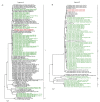Isolation of a New Infectious Pancreatic Necrosis Virus (IPNV) Variant from a Fish Farm in Scotland
- PMID: 33670941
- PMCID: PMC7997178
- DOI: 10.3390/v13030385
Isolation of a New Infectious Pancreatic Necrosis Virus (IPNV) Variant from a Fish Farm in Scotland
Abstract
The aquatic virus, infectious pancreatic necrosis virus (IPNV), is known to infect various farmed fish, in particular salmonids, and is responsible for large economic losses in the aquaculture industry. Common practices to detect the virus include qPCR tests based on specific primers and serum neutralization tests for virus serotyping. Following the potential presence of IPNV viruses in a fish farm in Scotland containing vaccinated and IPNV-resistant fish, the common serotyping of the IPNV isolates was not made possible. This led us to determine the complete genome of the new IPNV isolates in order to investigate the cause of the serotyping discrepancy. Next-generation sequencing using the Illumina technology along with the sequence-independent single primer amplification (SISPA) approach was conducted to fully characterize the new Scottish isolates. With this approach, the full genome of two isolates, V1810-4 and V1810-6, was determined and analyzed. The potential origin of the virus isolates was investigated by phylogenetic analyses along with tridimensional and secondary protein structure analyses. These revealed the emergence of a new variant from one of the main virus serotypes, probably caused by the presence of selective pressure exerted by the vaccinated IPNV-resistant farmed fish.
Keywords: IPNV; aquaculture; evolution; infectious pancreatic necrosis virus; phylogeny; variant.
Conflict of interest statement
The authors declare no conflict of interests.
Figures




Similar articles
-
Evolution of an Extended Pathogenicity Motif in VP2 of Infectious Pancreatic Necrosis Virus Isolates from Farmed Rainbow Trout in Turkey.Viruses. 2024 Jun 20;16(6):994. doi: 10.3390/v16060994. Viruses. 2024. PMID: 38932285 Free PMC article.
-
Infectious pancreatic necrosis virus (IPNV) serotype Sp is prevalent in Turkish rainbow trout farms.J Fish Dis. 2018 Jan;41(1):95-104. doi: 10.1111/jfd.12675. Epub 2017 Jul 26. J Fish Dis. 2018. PMID: 28745835
-
Genetic analysis of infectious pancreatic necrosis virus from Scotland.J Fish Dis. 2008 Jan;31(1):37-47. doi: 10.1111/j.1365-2761.2007.00864.x. J Fish Dis. 2008. PMID: 18086033
-
Molecular characterization of infectious pancreatic necrosis virus strains isolated from the three types of salmonids farmed in Chile.Virol J. 2017 Jan 31;14(1):17. doi: 10.1186/s12985-017-0684-x. Virol J. 2017. PMID: 28143585 Free PMC article.
-
Immunization with viral antigens: infectious pancreatic necrosis.Dev Biol Stand. 1997;90:191-9. Dev Biol Stand. 1997. PMID: 9270848 Review.
Cited by
-
Assessment of listing and categorisation of animal diseases within the framework of the Animal Health Law (Regulation (EU) No 2016/429): infectious pancreatic necrosis (IPN).EFSA J. 2023 Jun 12;21(6):e08028. doi: 10.2903/j.efsa.2023.8028. eCollection 2023 Jun. EFSA J. 2023. PMID: 37313317 Free PMC article.
-
Dynamic Distribution of Infectious Pancreatic Necrosis Virus (IPNV) Strains of Genogroups 1, 5, and 7 after Intraperitoneal Administration in Rainbow Trout (Oncorhynchus mykiss).Viruses. 2022 Nov 25;14(12):2634. doi: 10.3390/v14122634. Viruses. 2022. PMID: 36560638 Free PMC article.
-
Identification of a New Infectious Pancreatic Necrosis Virus (IPNV) Variant in Atlantic Salmon (Salmo salar L.) that can Cause High Mortality Even in Genetically Resistant Fish.Front Genet. 2021 Nov 26;12:635185. doi: 10.3389/fgene.2021.635185. eCollection 2021. Front Genet. 2021. PMID: 34899819 Free PMC article.
-
Evolution of an Extended Pathogenicity Motif in VP2 of Infectious Pancreatic Necrosis Virus Isolates from Farmed Rainbow Trout in Turkey.Viruses. 2024 Jun 20;16(6):994. doi: 10.3390/v16060994. Viruses. 2024. PMID: 38932285 Free PMC article.
-
Genomic Epidemiology of Salmonid Alphavirus in Norwegian Aquaculture Reveals Recent Subtype-2 Transmission Dynamics and Novel Subtype-3 Lineages.Viruses. 2021 Dec 20;13(12):2549. doi: 10.3390/v13122549. Viruses. 2021. PMID: 34960818 Free PMC article.
References
-
- Dobos P. The molecular biology of infectious pancreatic necrosis virus (IPNV) Annu. Rev. Fish Dis. 1995;5:25–54. doi: 10.1016/0959-8030(95)00003-8. - DOI
-
- Duncan R., Nagy E., Krell P.J., Dobos P.E. Synthesis of the infectious pancreatic necrosis virus polyprotein, detection of a virus-encoded protease, and fine structure mapping of genome segment A coding regions. J. Virol. 1987;61:3655–3664. doi: 10.1128/JVI.61.12.3655-3664.1987. - DOI - PMC - PubMed
Publication types
MeSH terms
Substances
LinkOut - more resources
Full Text Sources
Other Literature Sources

